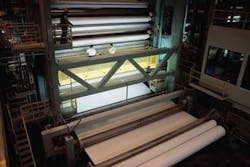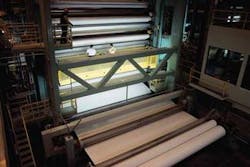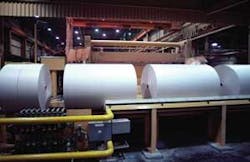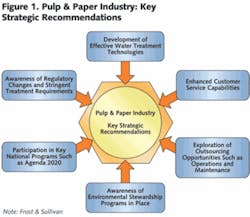Treating Pulp & Paper Water and Wastewater – A North American Perspective
by Eric Meliton
• Americans read over 24 billion newspapers, 2 billion books and 350 million magazines each year. Treating the water used to produce them is critical to ensuring a clean environment.
The pulp and paper industry has experienced significant growth over the last decade. As of 2008, North America remains the largest consumer of pulp and paper, while global demand for pulp and paper products has continued to increase in continents such as Asia and Africa.
Increased growth for the pulp and paper industry comes at a price. Ever-increasing production volumes have resulted in a gradual increase in waste production, air pollution, and energy consumption. For example, for every ton of pulp produced, about 17,000 gallons of industrial process water is required. Amongst the major manufacturing industries, pulp and paper remains one of the largest consumers of freshwater and energy as part of its standard manufacturing processes.
As a direct result of these demands, requirements of related wastewater treatment and sludge disposal methods are quite high. With factors such as global water shortages, increasing costs of fuel, and stringent environmental regulations, many industry participants in the pulp and paper marketplace have been persuaded to re-evaluate the issues related to water and wastewater treatment, often revolving around significant chlorine use for bleaching.
U.S. Sales on the Rise
Year after year, the pulp and paper industry serves as one of the leading industrial employers. Frost & Sullivan previously estimated that over 1.5 million people are employed in the U.S. pulp and paper industry, representing a highly skilled workforce. The U.S. pulp and paper industry is quite advanced in comparison to the world market, incorporating an extensive transportation infrastructure and an established domestic and export marketplace. In addition, it represents 7% of total U.S. manufacturing sales (valued at $240 billion), ranking seventh among manufacturing sectors in terms of gross domestic product.
Across the border, the Canadian pulp and paper industry represents over a third of the world’s newsprint supply. The Canadian industry supplies over half of the paper used for U.S. newspaper production. The U.S. is Canada’s largest customer for pulp and paper products. The Canadian industry is supported by the Forest Products Association of Canada (FPAC), similar to the American Forest & Paper Association (AF & PA) in the United States.
The recognized trade association of the pulp and paper industry, AF & PA members grow and harvest forests, produce wood fibers, and manufacture pulp and paper products from new and recovered fibers. The association strengthens industry efforts to develop environmental stewardship goals. Some of the recent achievements made by the members of the AF & PA are expressed in Figure 1.
Freshwater conservation is one of the major stewardship issues the pulp and paper industry is trying to address. Water is imperative in all major stages of paper production, including pulp making, pulp processing, and paper manufacturing (cooking, bleaching, and washing). In general terms, an average pulp mill requires 63 million liters of freshwater per day (inclusive of production requirements and associated wastewater production). On average, the cost of freshwater requirements and generated wastewater represents 10% of overall production costs. With ever-changing regulatory requirements and increasing freshwater rates, water related costs will continue to rise.
About 85% of water used in the pulp and paper industry is composed of contaminated wastewater. This is composed of effluent solids, sediments, absorbable organic halides (AOX), chlorinated organic compounds, chemical oxygen demand (COD), and biological oxygen demand (BOD) contaminants. Therefore, most pulp and paper mills have on-site primary and secondary water treatment plants to treat wastewater immediately before reuse or discharge. In addition to wastewater treatment requirements, residual sludge waste streams are also a treatment issue. Sludge represents the largest volume of waste stream generated by the industry. Residual sludge is mainly composed of boiler and furnace ash, scrubber sludge, lime mud, wood processing residuals, and various effluent solids previously mentioned.
Regulatory Compliance
The pulp and paper industry is highly regulated. Like other manufacturing industries, this sector is subject to federal, state and local environmental regulations. In relation to water-related requirements, the Clean Water Act and the Resource Conservation & Recovery Act (RCRA) apply to this industry. In relation to regulations, clean-up actions, on-site and off-site contamination issues, and potential penalties are common to the pulp and paper industry. Annual costs related to remediation and environmental compliance represents millions of dollars of potential risk and resource allocation each year for industry participants. As the environmental regulations continue to tighten, related compliance costs will continue to rise.
One of the more prominent environmental concerns relevant to the pulp and paper industry is the chlorinated organics produced by standard bleaching processes. The U.S. Environmental Protection Agency’s Office of Water recommends specific technologies be developed to reduce production of bleaching contaminants from the chemical pulping process.
AF & PA members have developed Elemental Chlorine Free (ECF) processing. ECF processing is a bleaching chemistry that utilizes chlorine dioxide capabilities to eliminate dioxin from effluent discharges. It’s becoming the world recognized standard for the bleaching process. The U.S. pulp and paper industry has converted various standard mills to utilize the ECF bleaching process and has invested over $1 billion to incorporate this technology. ECF was recently recognized as the “Best Available Technology” by the EPA and European Commission and thus represents the strongest innovation of recent years to improve water conservation.
Leading Industry Trends
Environmental stewardship is one of the leading industry trends for the pulp and paper sector. Being able to maintain a healthy environment, while developing improvements to enhance the bottom line is good for all aspects of the industry.
The reduction of effluent discharges and demand on freshwater resources will continue to create industry demand for new technologies and processes. Stringent regulations and related compliance costs will increase need for updated treatment systems and treatment technologies.
Frost & Sullivan previously reported the pulp and paper market in the mature stage; however, the aging infrastructure will continue to drive growth in the repair and retrofit market. In addition, upgrades and expansions of water and wastewater treatment systems offer emerging opportunities in this market.
One of the more recent trends concerning this industry is the extensive competition from global counterparts. Countries in Asia and Latin America have increased papermaking capabilities and have competitive advantages such as faster-growing trees and lower labor costs.
What are the solutions?
Standard treatment equipment will continue to be at the forefront of the pulp and paper water and wastewater treatment marketplace. This includes technology such as clarifiers and aeration equipment that would continue to provide suppliers with strong market opportunities. Sludge handling processes such as dewatering, drying and incineration also will provide vendors with opportunities in the sector.
Newer technological applications such as membrane separation, tertiary biofiltration, ozonation treatment, wet oxidation treatment, fixed bed biofilm processing, nitrogen fixation, and aerobic biotechnological treatment methods will increase in demand as antiquated pulp and paper mills are upgraded to meet current treatment standards.
Another solution being incorporated into the pulp and paper industry includes chemical recovery. This process recovers chemicals from spent cooking liquor. Some of the benefits of this process include economic savings, reduction of effluent discharges, and the generation of energy from residue burning.
A more comprehensive solution has been the joint research project entitled Agenda 2020. This project consists of a partnership that exists between AF & PA members, the U.S. Department of Energy, and national research institutions and laboratories. The goal of Agenda 2020 is to develop new technologies and processes to enhance overall energy use, cost-effectiveness and improving productivity for the pulp and paper industry. Some of the promising projects that are in development include the use of bio-refineries and nanotechnologies.
The bio-refinery concept will retrofit existing pulp and paper mills to utilize renewable power, bio-products, fuels and chemicals. This will be accomplished by implementing biomass conversion technologies into existing mill designs. The nanotechnology concept will develop new intelligent composite and paper products with the ability to measure production aspects such as moisture, temperature and chemical levels. This development could represent a breakthrough for innovative production materials for the pulp and paper industry.
What are the next steps?
To increase market share in the pulp and paper water and wastewater treatment industry, the following strategic recommendations can be incorporated to address the various industry needs:
- Development of effective water treatment technologies
- Enhancement of customer service capabilities
- Exploring interest in outsourcing capabilities of on-site water and wastewater treatment facilities – operations & maintenance (O&M) opportunities
- Development of innovative technologies such as UV treatment, membrane separation, and sludge treatment
- Awareness of environmental stewardship opportunities
- Participation in national programs to develop new technologies such as Agenda 2020
- Awareness of competition from Asian and Latin American counterparts
- Awareness of regulatory changes and stringent treatment requirements
- Establish brand name reputation and influence for specific treatment capabilities
- Enhancement of customer loyalty amongst existing clients by providing innovative technologies.
About the Author: Eric Meliton is a research analyst with the Palo Alto, CA-based global growth consulting company Frost & Sullivan’s North American Environmental & Building Technologies practice. Before this, he was a QA Specialist / AQPIC at UPS Supply Chain Solutions. Contact: [email protected] or www.frost.com
Figure 1. American Forest & Paper Association membership achievements
- Reduction in average energy use by 17%
- Reduction in fossil fuel and energy consumption by 38%
- Reduction of 50% less industrial water used per ton of product as compared to 1975 values
- Increased use of renewable biofuels by 46%
- Increased use of recovered paper by 37%
- Number of users utilizing recovered fibers represents 83%
- Spending of over $1 billion to develop technology to eliminate dioxin discharge
- Spending of over $25 billion since 1970 to reduce manufacturing effects on natural environment



